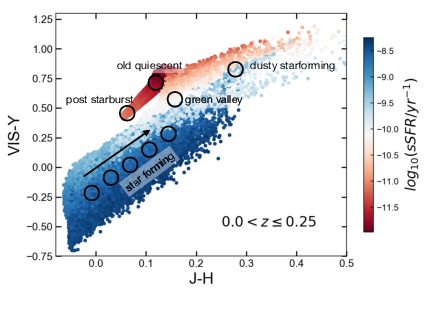Euclid: The selection of quiescent and star-forming galaxies using observed colours
| Authors: | L. Bisigello, ..., V. Pettorino, S. Pires, F. Sureau, et al. |
| Journal: | MNRAS |
| Year: | 2020 |
| DOI: | 10.1093/mnras/staa885 |
| Download: |
Abstract
The Euclid mission will observe well over a billion galaxies out to z∼6 and beyond. This will offer an unrivalled opportunity to investigate several key questions for understanding galaxy formation and evolution. The first step for many of these studies will be the selection of a sample of quiescent and star-forming galaxies, as is often done in the literature by using well known colour techniques such as the `UVJ' diagram. However, given the limited number of filters available for the Euclid telescope, the recovery of such rest-frame colours will be challenging. We therefore investigate the use of observed Euclid colours, on their own and together with ground-based u-band observations, for selecting quiescent and star-forming galaxies. The most efficient colour combination, among the ones tested in this work, consists of the (u-VIS) and (VIS-J) colours. We find that this combination allows users to select a sample of quiescent galaxies complete to above ∼70% and with less than 15% contamination at redshifts in the range 0.75<z<1. For galaxies at high-z or without the u-band complementary observations, the (VIS-Y) and (J-H) colours represent a valid alternative, with >65% completeness level and contamination below 20% at 1<z<2 for finding quiescent galaxies. In comparison, the sample of quiescent galaxies selected with the traditional UVJ technique is only ∼20% complete at z<3, when recovering the rest-frame colours using mock Euclid observations. This shows that our new methodology is the most suitable one when only Euclid bands, along with u-band imaging, are available.

